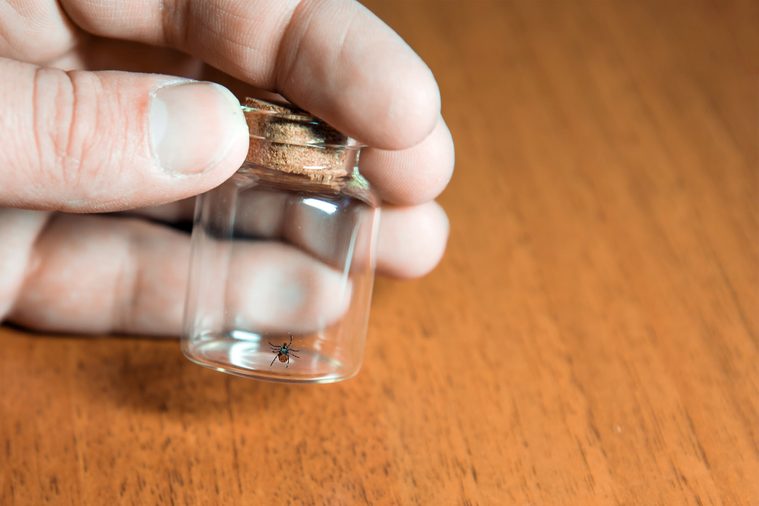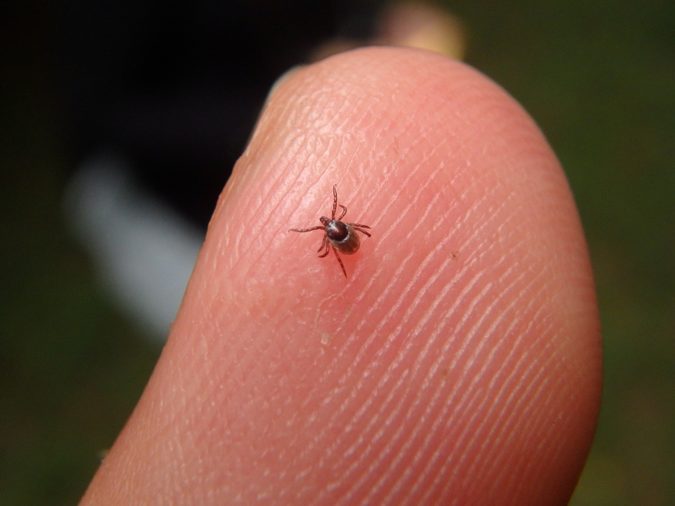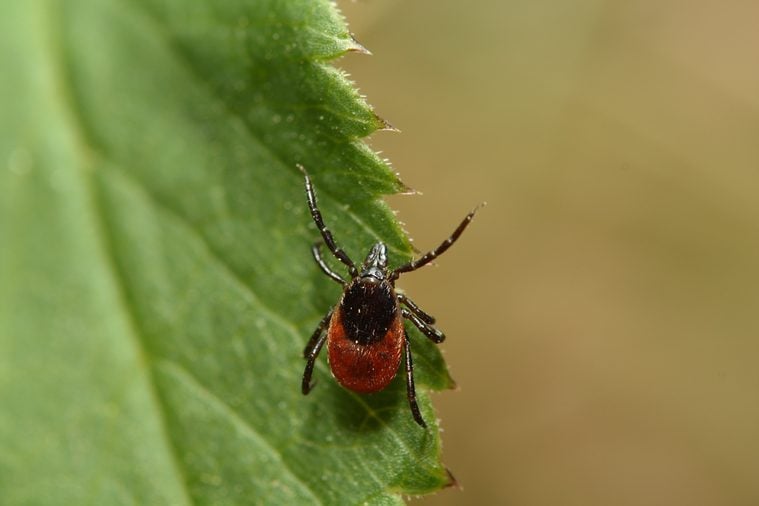
Using nail polish
Grandma may have had good intentions when she told you to coat an embedded tick with nail polish. Grandma should have saved her nail polish advice for stopping pantyhose runs (which totally works). The polish may suffocate the bug eventually, but by that time, you may already have been infected with a disease. You need to remove it right away, and according to the CDC, good tweezers are the safest and fastest way. Grab the tick as close to the skin as you can possibly get and pull. A slow and steady hand is best: Take your time to avoid jerking as you don’t want any of the tick’s mouth parts left behind.

Bug burning
Another old wives’ tale that has been totally debunked is that holding a match near the tick will cause it to let go. Wrong again. All this will do is possibly give you a burn and panic the tick so that it regurgitates and increases the risk of infection, reports the New York Times. Luckily, there’s a better way to remove a tick—check it out.

Mowing the lawn
Keeping a well-manicured lawn will help keep ticks at bay; they prefer longer grass. But while a well-tended yard may reduce ticks, it won’t eliminate them. In fact, the Connecticut Agricultural Experiment Station Tick Management Handbook sites a computer simulation demonstrating that landscape management alone resulted in the “prevention of only a moderate number of Lyme disease cases in comparison.” You only need one tick bite to get infected. Don’t stop mowing, but be sure to take other precautions, too. Lyme disease actually is only one of several tick-borne diseases you need to watch out for this summer.

Avoiding DEET
This very effective bug repellent suffers from a perception problem, according to the Los Angeles Times. Its bad rep persists despite many studies and both the CDC and EPA saying it is perfectly safe to use. “In the more than 45 years that DEET has been used in the U.S., reports of adverse effects in humans associated with the dermal application of DEET have been relatively rare, given the billions of applications of the repellent,” says the Agency for Toxic Substances and Disease Registry, part of the U.S. Department of Health and Human Services. Still leery? Look for lower-concentration sprays—30 percent-strength DEET is all you need.

Washing your clothes
You would think a little laundry detergent and hot water would take care of any ticks that have hitched a ride on your clothes. But ticks thrive in moist environments; a ride in the washer can be nothing to the parasite. It’s the dryer that’s a tick’s worst nightmare. The dry heat will kill them. Although it might seem counter-intuitive, dump your clothes in the dryer before washing. Run the dryer on regular heat for a full cycle—not permanent press. Don’t be surprised if you find dried husks of dead ticks in the lint filter.

Hitting the shower
The first thing you probably want to do if ticks are giving you the creepy crawlies is to jump in the shower. And showering is a good thing as it can help wash off any loose ticks, but the keyword here is loose. If a tick has already burrowed in your skin, they won’t come off just by showering. That said, the shower is the perfect place to do a full body for any ticks that may have latched onto you. Take a hand-held mirror in with you so you can check every crevice—from between your toes to your belly button to parts that never see the light of day. A mirror check is one of the 10 things you need to do right now if you’ve been bitten by a tick.

Wearing long clothes
You’ve heard that long-sleeved shirts and pants will keep ticks off, but they have no problem creeping up your ankle and under your pants. New research confirms there is a way to stop ticks—wear clothes treated with the repellent permethrin, according to CBS News report on a new U.S. government study. This insecticide is derived from the chrysanthemum flower, and it’s effective: “All tested tick species and life stages experienced the ‘hot-foot’ effect after coming into contact with permethrin-treated clothing,” said senior researcher Lars Eisen of the U.S. Centers for Disease Control and Prevention. Check out suppliers like Insect Shield: You can send them everything from socks to pants to bandanas, and they’ll treat all your items with permethrin. The treatment lasts through 70 washings.

Testing negative
Unfortunately, you may not be in the clear just because a blood test is negative for Lyme. According to an article in USA Today, if you have symptoms consistent with Lyme, you may want to seek out a Lyme-literate doctor for another opinion. Lyme disease is tricky to diagnose since many of the symptoms—headache, joint pain, or blurred vision—could be passed off as the flu or some other infection. And bulls-eye rashes appear in less than half of all Lyme cases. Don’t miss these 18 other silents signs of Lyme disease, either.

Squashing it
Not when it comes to ticks. You could end up infecting yourself. If you must kill them, drop them into a container full of alcohol. Take note: You might want to consider bagging that bug to save for testing in case you come down with symptoms.

Drowning ’em
Jumping in a pool or taking a nice hot bath won’t drown a tick, reports Time magazine. If they’re already attached to your skin, the wetness may encourage them to bore deeper into your skin—just one of the things that ticks don’t want you to know.

Expecting to feel the bite
Most people have no clue they’ve been bitten by a tick. That’s because a tick’s saliva acts like anesthesia, reports Time. And although you may be able to spot an adult tick, it’s much more difficult to see a nymph, which is about the size of a tiny poppy seed. All you need is one of those little ‘poppyseeds’ to burrow in without being removed and they’ll feed for days.

Thinking no wings means no problem
Ticks may not be able to fly, but they get around just fine. According to Time, they don’t need wings for “questing” (how they catch and hold on to their next host): Using their rear legs, they cling to grass or leaves and then stretch out their front legs to jump on their next victim. If you suspect you might be heading somewhere that’s populated with ticks, make sure you know these 9 tricks tips to avoid getting any tick-borne illnesses.